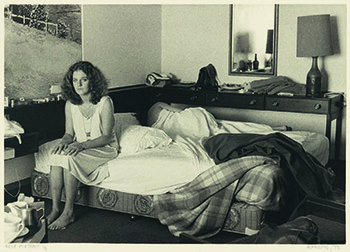PHOTOGRAPHS BY CAROL JERREMS: THE PROPERTY OF CATRIONA [KATRINA] BROWN, MEXICO, LOTS 1 - 5
In 1975, Carol Jerrems discussed with friend Catriona Brown the latter’s need for headshots for her portfolio. Brown was an aspiring actor and Jerrems an up-and-coming photographic artist. In return for the conventional headshots Jerrems suggested Brown pose for her and the iconic images taken at Vale and Mozart Streets in Melbourne came into being. As Brown relates:
‘Vale Street was the home of my girlfriend Jacky Trusty…The jacket and ankh I was wearing belonged to her, they dressed me for the shoot. Jacky was also good friends with Carol… charming and insightful she was well known in the club and music scene… After the shoot at Vale Street, we moved to Mozart Street where our friend Ian Macrae lived…’1
jERREMS.jpg

It is clear from looking at Jerrems’ proof sheets how events unfolded during the afternoon. Brown arrived at Vale Street to find two teenaged boys, Mark Lean and Jon Bourke with Jerrems. They were students from Heidelberg Technical School where Jerrems taught in 1973 and 74. Jerrems had involved herself closely in the lives of her pupils, photographing and filming them, meeting them out of school. Variously described as sharpies and underprivileged, the boys and their peers were willing participants. Jerrems was only ten years older and brought an expansiveness to life and learning at the school.
In March 1975, the two boys are encouraged to remove their t-shirts and sweaters. Framed by leaves and set against a dark ground the environment becomes enigmatic. Catriona removes her top and her pale face and body move forward to centre stage. The boys flank her yet recede, their gazes sombre. It has taken some time to get to this point. Brown is luminescent, her eyes are completely engaged with the camera and therefore with us. The silver ankh at her neck signals life and power.
In a 1999 interview Brown said, ‘[Carol] chose the boys being angry, cunning, and watching carefully, guarding themselves against my openness, directness and honesty… She was a great observer of people.’2 This applies as much to Mozart Street as to Vale Street. In Mozart Street, the boys mirror each other in the background while Catriona is nonchalant in the foreground.
Jerrems’ choreography is evident in many of her most successful photographs. Her involvement with moving as much as still image, her life within the art and political scenes of the 1970s, brought a very different inflection to how she used the photographic medium. Rather than the standard mid-twentieth century hit and run photojournalism, Jerrems had learnt from filmmaking and photodocumentary how to forge her own approach to engaging with her subjects. Unlike the compelling and off-centred style of Diane Arbus, or the overriding search for the single unique image, Jerrems noted her ‘interest in photographic filmmaking (filmic photography) [and]sequential imagery….’3 In 1977 she wrote, ‘I try to reveal something about people, because they are so separate, so isolated, maybe it’s a way of bringing people together. I don’t want to exploit people. I care about them.’ 4
Jerrems used Vale Street in different ways, from the crop which focusses on Catriona Brown and Mark Lean only, to the 1976 Juliet holding Vale Street.5 Variations arise with other images from the shoot, specifically Mark Lean with Catriona where the two are clothed, relaxed and can be read as two young people simply horsing around. The pairing of this photograph with the cropped version of Vale Street is instructive. Both are vertical format and the same subjects yet they read very differently – in the first, the fair woman is against a dark ground, the dark boy against a pale ground. Catriona stands behind with her hands on Mark’s arm and chest, her pale jacket in contrast to his dark sweater. In the cropped version of Vale Street positions are reversed, the clothing gone and expressions otherwise. The powerful ambiguity of the photographic image is fully revealed.
Jerrems had graduated from Prahran Technical School in 1971 and the National Gallery of Victoria, Melbourne acquired her Alphabet Folio that year. She was the first woman photographer to enter the collection. Filmmaker Paul Cox had been an important teacher and mentor at Prahran encouraging his students to take a holistic and spontaneous approach to photography and film, an ethos Jerrems fully embraced. For the duration of the 1970s until her premature death from Budd-Chiari syndrome in 1980, Jerrems was highly active as a teacher, photographer and filmmaker dedicated to social change. The major archive of her work is held at the National Gallery of Australia, Canberra.
1. Correspondence between Catriona Brown and Chris Deutscher 2021
2. King, N., ed. Up Close: Carol Jerrems with Larry Clark, Nan Goldin and William Yang, Heide Museum of Modern Art & Schwartz City, Melbourne 2010 p 47
3. Ibid p 21
4. cs.nga.gov.au/detail.cfm?irn=96378 accessed 24/03/2021
5. Op.cit. various essays deal in depth with the different aspects of Jerrems’ work and the evolution of Vale Street
JUDY ANNEAR
Judy Annear is a writer and researcher based in Victoria on Dja Dja Wurrung land, never ceded. She is an Honorary Fellow at the University of Melbourne School of Culture and Communication.